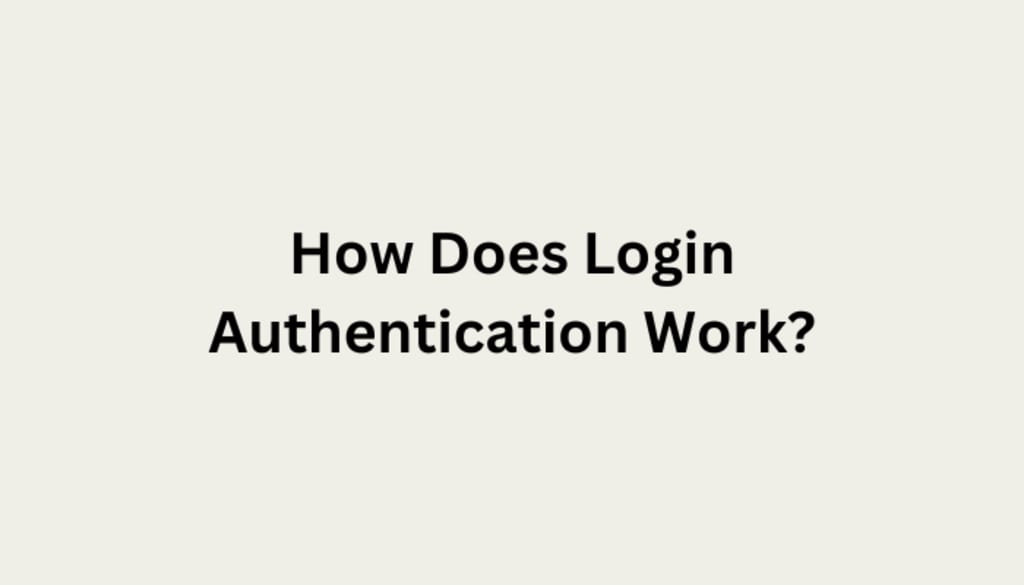How Does Login Authentication Work?
Understanding the Mechanics and Importance of Securing User Access.

In today’s digital world, securing access to systems, applications, and data is more critical than ever. Login authentication is a fundamental component of cybersecurity, serving as the first line of defense against unauthorized access. Understanding how login authentication works can help individuals and organizations implement effective security measures to protect sensitive information. This blog will explore the mechanics of login authentication, its importance, various methods, and best practices.
What is Login Authentication?
Login authentication is the process of verifying the identity of a user attempting to access a system or service. It ensures that the person claiming to be a user is indeed who they say they are. This process typically involves checking the provided credentials, such as a username and password, against stored information in a database.
The Importance of Login Authentication
- Security: Protects sensitive data and systems from unauthorized access.
- Trust: Builds user confidence in the security of a platform.
- Compliance: Helps meet regulatory requirements for data protection.
- Access Control: Ensures only authorized users can perform certain actions or access specific information.
How Login Authentication Works
The login authentication process generally follows these steps:
- Credential Submission: The user inputs their credentials (e.g., username and password) into the login interface.
- Credential Transmission: These credentials are securely transmitted to the authentication server.
- Credential Verification: The server verifies the credentials by comparing them to stored data.
- Access Granting: If the credentials match, access is granted; if not, access is denied.
Let’s delve deeper into each of these steps:
1. Credential Submission
When a user attempts to log in, they provide credentials to prove their identity. The most common credentials are a username and password. Other methods might include biometric data (fingerprints, facial recognition) or physical tokens.
2. Credential Transmission
Once the credentials are entered, they are sent to the authentication server for verification. This transmission must be secure to prevent interception by malicious actors. Typically, secure protocols like HTTPS (Hypertext Transfer Protocol Secure) are used to encrypt the data during transmission.
3. Credential Verification
The authentication server receives the credentials and compares them to stored information. The process varies depending on the authentication method used:
- Password Authentication: The server checks the entered password against the stored hash of the user’s password. Storing passwords as hashes rather than plain text enhances security.
- Biometric Authentication: The server compares the biometric data provided (e.g., fingerprint) with the stored template.
- Token-Based Authentication: The server validates the token’s information, such as a time-based one-time password (TOTP).
4. Access Granting
If the credentials match the stored data, the server grants access to the user. If there is a mismatch, the server denies access and may prompt the user to retry or provide additional authentication factors.
Types of Login Authentication Methods
There are several methods of login authentication, each with its own advantages and use cases:
Password-Based Authentication:
- Simple and Widely Used: Passwords are easy to implement and use.
- Security Concerns: Passwords can be weak, reused, or stolen through phishing or data breaches.
Two-Factor Authentication (2FA):
- Enhanced Security: Requires two forms of verification, typically a password and a second factor like a text message code or an authenticator app.
- How It Works: After entering the password, the user must provide a second piece of information, adding an extra layer of security.
Multi-Factor Authentication (MFA):
- Even Stronger Security: Involves two or more verification factors, such as something you know (password), something you have (security token), and something you are (biometric data).
- Examples: Password + fingerprint, password + facial recognition, or password + smart card.
Biometric Authentication:
- Unique Identifiers: Uses physical characteristics such as fingerprints, facial recognition, or iris scans to verify identity.
- High Security: Difficult to replicate, making it a secure option. However, biometric data must be protected, as it cannot be changed if compromised.
Token-Based Authentication:
- Physical Devices: Users are given a physical token that generates a one-time password (OTP) for each login attempt.
- Secure but Requires Hardware: This method provides strong security but requires the user to carry the token device.
Single Sign-On (SSO):
- Convenience and Security: SSO allows users to authenticate once and gain access to multiple systems without re-entering credentials.
- Centralized Management: Simplifies user management and enhances security by reducing password fatigue.
Public Key Infrastructure (PKI):
- Advanced Security: Uses pairs of cryptographic keys (public and private) to authenticate users.
- Highly Secure: Often used in environments requiring stringent security, such as government and military applications.
Best Practices for Login Authentication
To ensure robust login authentication, consider these best practices:
- Enforce Strong Password Policies: Require complex passwords that are difficult to guess or crack.
- Implement Multi-Factor Authentication (MFA): Use MFA to add an extra layer of security, especially for accessing sensitive information.
- Use Secure Protocols: Ensure that data transmission during authentication is encrypted using protocols like HTTPS.
- Regularly Update and Patch Systems: Keep authentication systems up to date to protect against vulnerabilities.
- Educate Users: Train users on the importance of strong authentication practices and how to recognize phishing attempts.
- Monitor and Audit: Regularly monitor login attempts and audit authentication systems to detect and respond to potential threats.
The Future of Login Authentication
As cyber threats evolve, so do authentication technologies. Emerging trends include:
- Behavioral Biometrics: Analyzing user behavior, such as typing patterns or mouse movements, to verify identity.
- Passwordless Authentication: Moving away from traditional passwords towards more secure methods like biometrics or hardware tokens.
- AI and Machine Learning: Using AI to detect unusual login patterns and predict potential security threats.
Conclusion
Understanding how login authentication works is crucial for protecting sensitive data and systems in the digital age. By implementing robust authentication methods and following best practices, individuals and organizations can enhance their security posture and safeguard against unauthorized access. As technology evolves, staying informed about new authentication methods and trends will be key to maintaining strong security measures.
About the Creator
Enjoyed the story? Support the Creator.
Subscribe for free to receive all their stories in your feed. You could also pledge your support or give them a one-off tip, letting them know you appreciate their work.





Comments
There are no comments for this story
Be the first to respond and start the conversation.